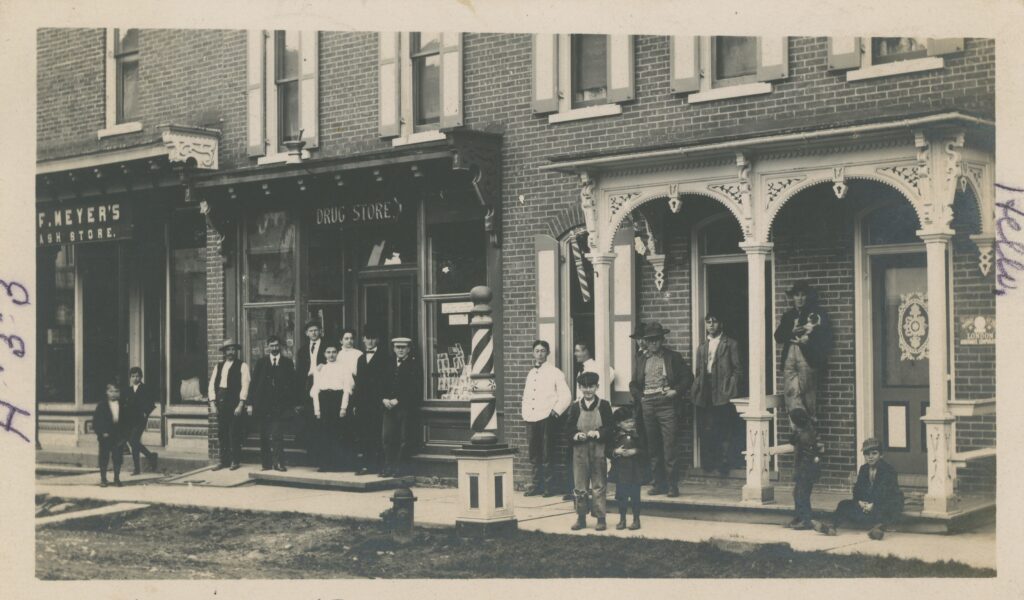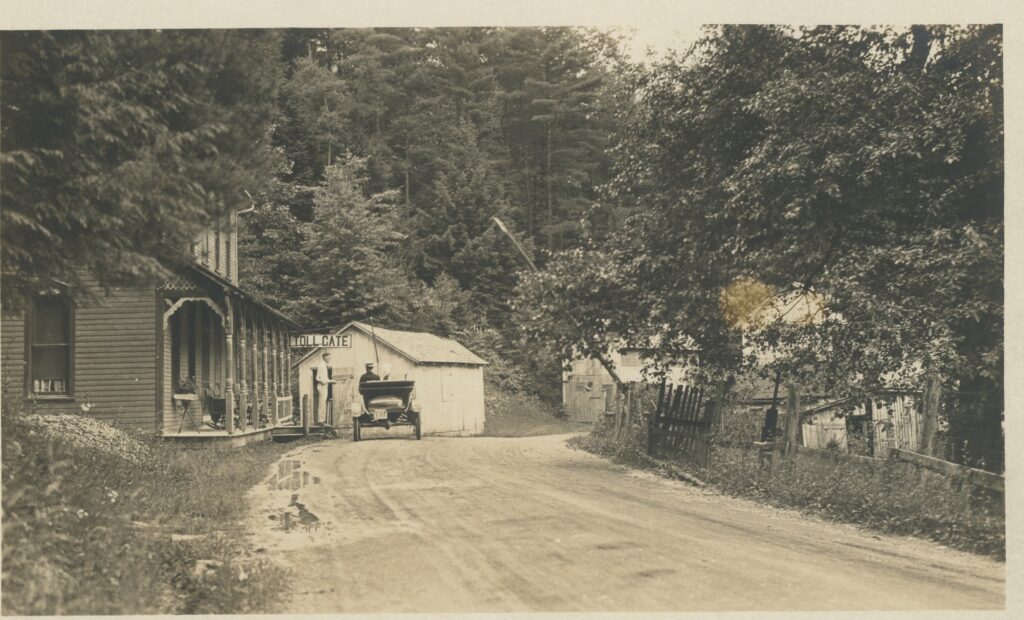Millheim is a historic Centre County community that for more than 150 years was the industrial center of Penns Valley. Its history has been shaped by Elk Creek, which provided power to the mills that gave the borough its name.
In 1771, Reuben Haines, an ironmaster, cut a road from the west bank of the Susquehanna River to Spring Mills, and settlers slowly began moving in. After the Revolutionary War, more settlers arrived, including Jacob Hubler, who built two mills on Elk Creek. Other settlers, mostly German but some Scotch-Irish, moved to the area, and the town became known as Mill Heim (German for “Home of the Mills”).
Elk Creek rises in the mountains at the eastern end of Brush Valley and flows southwest until it enters the gap connecting Brush and Penns valleys. The creek then turns southerly through the gap, which has been named the Narrows, and flows through Millheim for two miles south before emptying into Pine Creek.

In 1794, two schools were built, one for German speakers and one for English speakers. That same year a tavern and hotel opened. It operated under several names, including the National, the Black Hotel, and the Breon, before becoming the Milheim Hotel. The early 1800s marked the beginning of congregations that would found St. Luke’s Methodist Church and the United Brethren Church of Christ.
Residents realized that Haines Road had to be improved if the community was going to prosper. In 1810, the Buffalo and Penns Valley Turnpike was chartered, but the effort to link it with the rest of the county languished. Fifteen years later, the Bellefonte, Aaronsburg and Youngmanstown Turnpike connected Buffalo Valley with Bellefonte. Most of that road eventually became Pennsylvania Route 45, which passes through Millheim and Penns Valley.
The Millheim post office opened in 1824. St. Luke’s Methodist Church was built in 1842; a new brick church was completed in 1886. St. John’s Lutheran was established in 1877, and the congregation built a new church in 1881.
By mid-century Millheim was steadily growing. In 1857, a new school opened. The two-story building not only housed the school, but also the town hall and space for fire equipment. Union Cemetery was established on West Main Street and became the community’s principal burial ground for more than seventy-five years.
In the decades after the Civil War, Milheim became a thriving community. Pomeroy’s Atlas of 1874 listed more than ten commercial establishments, as well as two flour mills, two tanneries, two foundries, a planning mill, a saw mill, a woolen mill, a dye house, a stone quarry, a nail factory, a silk mill, a shoe factory, a cigar factory, and a hosiery.
Like other communities in the late 1800s, Millheim had a coronet band and community chorus. For decades, men played on the Millheim baseball team. The Ladies Literary Club met twice monthly.
In 1873, George Foote purchased Aaronsburg’s weekly German-language newspaper, the Centre Berichter, and moved it to Millheim. The newspaper, founded in 1827, was still published in German, but three years later it was renamed the Millheim Journal and began publishing in English.
When Milheim was incorporated as a borough on February 2, 1879, it was home to about 600 residents. By that time, the Lewisburg, Centre, and Spruce Creek Railroad had extended its line to Coburn to accommodate a growing lumber industry. The Millheim Turnpike Company built a road to Coburn. The town’s hotels jointly operated a stage service between Millheim and the Coburn railroad station.
A fire in 1885 destroyed several structures on West Main Street. Four years later, heavy rains turned Elk Creek into a torrent of water that swept through the town, destroying or damaging many commercial and residential structures. Fortunately, no one was killed. A relief committee was quickly established, and townspeople began rebuilding. Many of the new homes reflected the Victorian style popular at the time.
The Harrison Hosiery Mill opened in 1897 and eventually became the town’s chief employer. In 1905, it was sold to John H. Hoffman, who renamed it the Millheim Knitting Mill. At its peak in the 1940s, the plant employed 300 workers and turned out 1,600 socks a day. During the Great Depression, the mill was one of the few employers in the borough.
In 1896, the Millheim School Board built a two-story school on North Street for all the town’s students. By 1926, the school supported an orchestra and football, track, and baseball teams.
Two years later, the town joined with Haines and Penn townships to build the East Penn High School, which enrolled students for three decades. The school had four classrooms, a gymnasium, and offices. Along with sports teams, the school supported a band, a choral society, a drama club, a school newspaper, and a Future Farmers of America chapter.
Millheim joined the growing number of towns in the county with movie theaters when the Municipal Theatre opened in 1917. Silent films were shown until the talkies took over in 1933. Films were shown daily from Monday through Saturday. Theatrical shows also were performed regularly.

After World War II, new housing developments were built outside of downtown. In the 1950s, the Penns Valley Area School District was formed, and in 1956 a new junior/senior high school opened on Route 45. The old East Penn High School building is used today by the borough.
In 1958, the Millheim Knitting Mill was sold and continued operating as the Silver Crest Hosiery Company. The mill closed in 1969 and its last vestige, the water tower, was demolished in 1985.
As the mills closed, Millheim became a business and civic center for the agricultural community surrounding it. For decades, horse sales on Main Street were held from the late winter to the early spring. Old Order Amish families moved to the area in the 20th century, and today they operate some of the largest farms in Penns Valley.
By the time Millheim celebrated its centennial in 1979, downtown looked far different. Burkholder’s Market had moved to the west side of town. Hosterman and Stover Hardware, which opened in 1894, moved from downtown in 1993.
In recent years, downtown has seen a slow revival. Several new businesses have opened, notably Elk Creek Café and Aleworks and the Green Drake Gallery and Arts Center. Fountain Park, with a gazebo, benches, and a restored fountain, was built in 2001.
Today, Milheim has a population of about 900. Although the Millheim National Historic District includes 388 structures, the brick mill at 102 Mill Street is the only mill still standing, and it no longer operates.
Ford Risley
Sources:
Milheim: Home of the Mills, 1988
Brueggebors, Barbara. “Cornerstone store plans move form Millheim’s business district,” Centre Daily Times, December 19, 1993.
Brueggebors, Barbara. “Fountain the Focus in Milheim Park Project,” Centre Daily Times, March 30, 2000.
Pennypacker, Mary Elizabeth. “A Study of Place: The Linear Town in Centre County, PA.”
Historic Buildings of Centre County Pennsylvania. The Historic Registration Project of Centre County Library. Gregory Ramsey, Coordinator. University Park: Keystone Books, 1980
First Published: August 28, 2023
Last Modified: October 31, 2023
